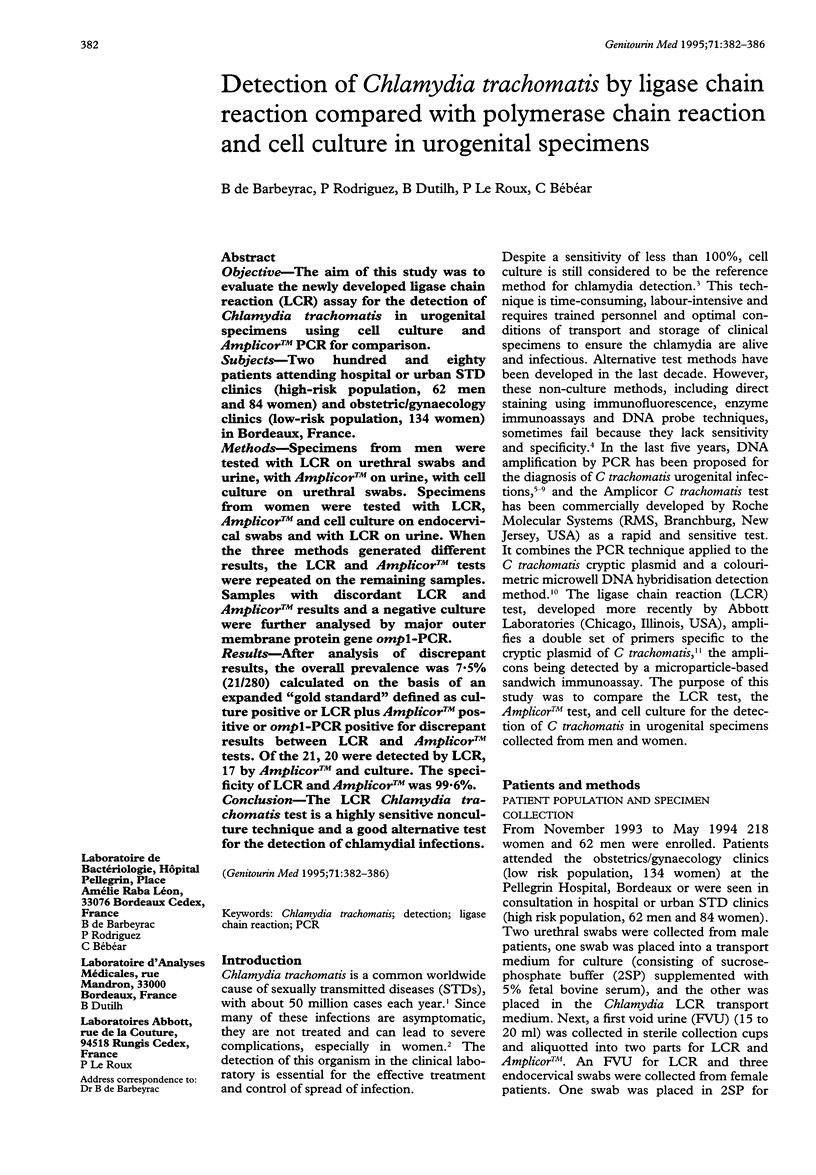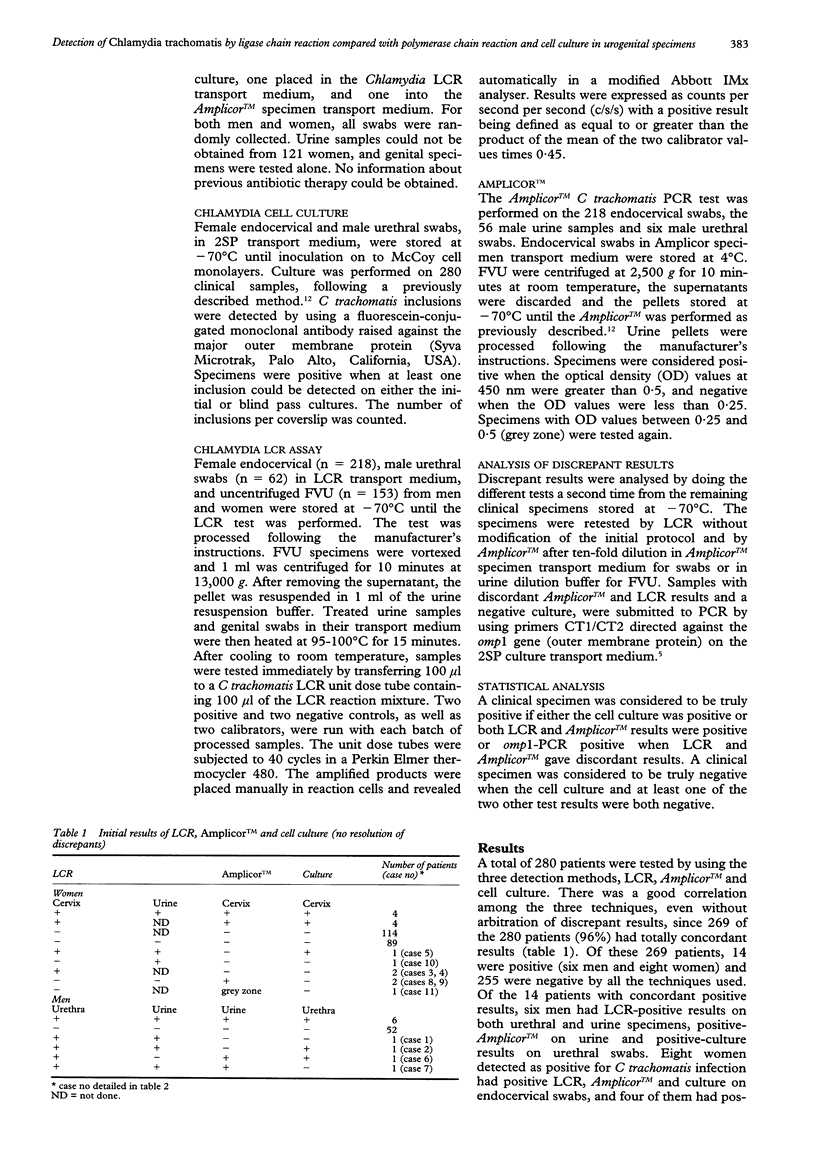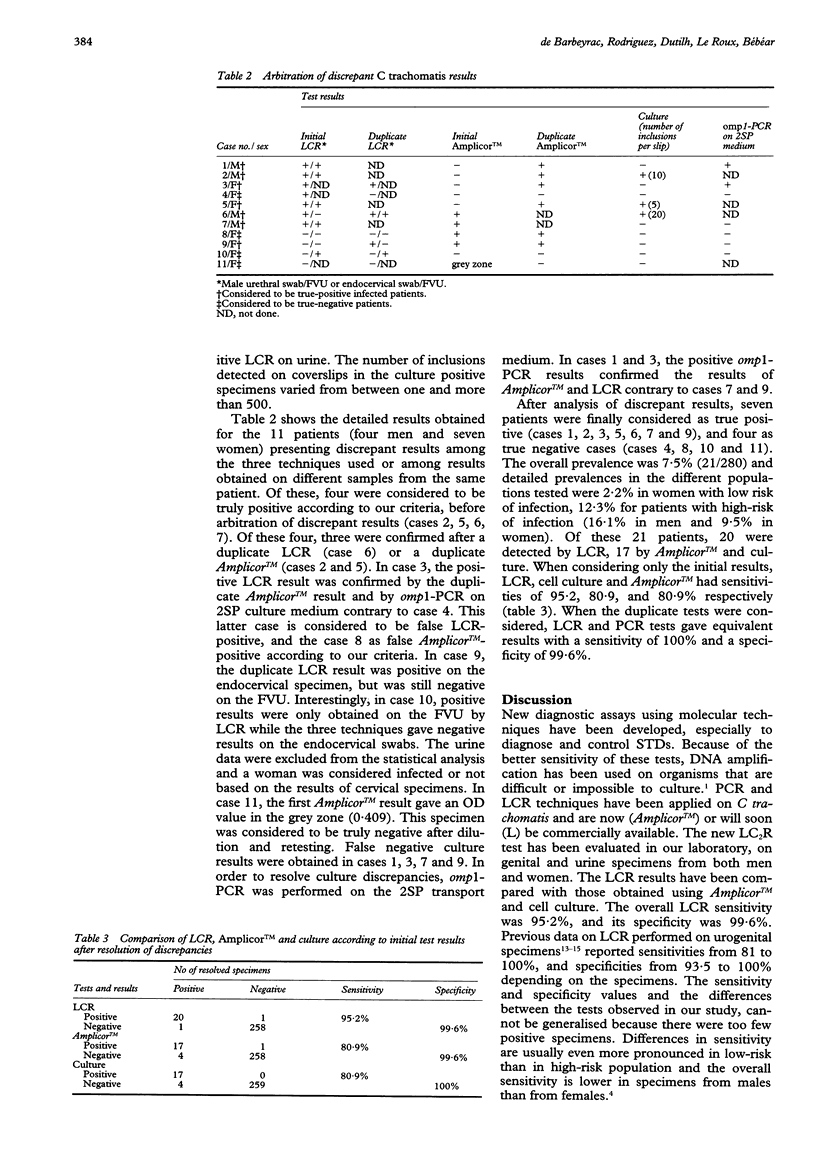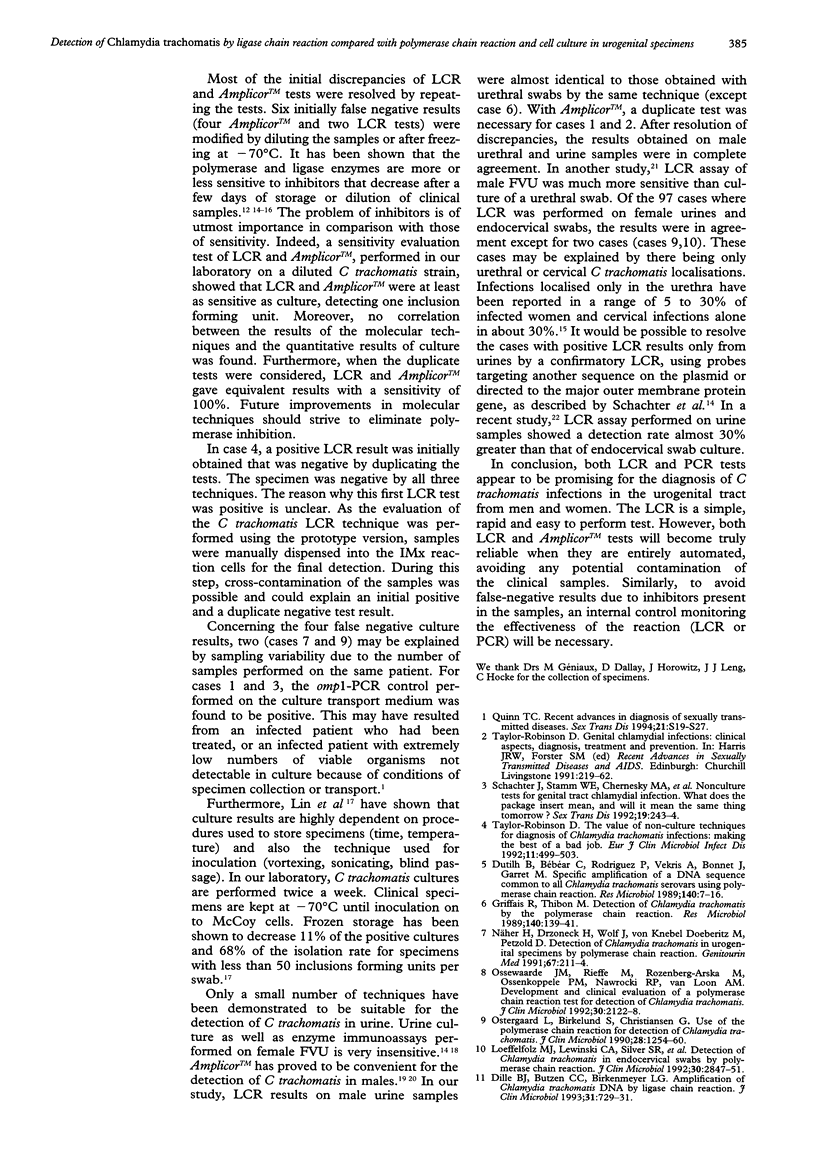Abstract
OBJECTIVE--The aim of this study was to evaluate the newly developed ligase chain reaction (LCR) assay for the detection of Chlamydia trachomatis in urogenital specimens using cell culture and Amplicor PCR for comparison. SUBJECTS--Two hundred and eighty patients attending hospital or urban STD clinics (high-risk population, 62 men and 84 women) and obstetric/gynaecology clinics (low-risk population, 134 women) in Bordeaux, France. METHODS--Specimens from men were tested with LCR on urethral swabs and urine, with Amplicor or urine, with cell culture on urethral swabs. Specimens from women were tested with LCR, Amplicor and cell culture on endocervical swabs and with LCR on urine. When the three methods generated different results, the LCR and Amplicor tests were repeated on the remaining samples. Samples with discordant LCR and Amplicor results and a negative culture were further analysed by major outer membrane protein gene omp1-PCR. RESULTS--After analysis of discrepant results, the overall prevalence was 7.5% (21/280) calculated on the basis of an expanded "gold standard" defined as culture positive or LCR plus Amplicor positive or omp1-PCR positive for discrepant results between LCR and Amplicor tests. Of the 21, 20 were detected by LCR, 17 by Amplicor and culture. The specificity of LCR and Amplicor was 99.6%. CONCLUSION--The LCR Chlamydia trachomatis test is a highly sensitive nonculture technique and a good alternative test for the detection of chlamydial infections.
Full text
PDF




Selected References
These references are in PubMed. This may not be the complete list of references from this article.
- Bassiri M., Hu H. Y., Domeika M. A., Burczak J., Svensson L. O., Lee H. H., Mårdh P. A. Detection of Chlamydia trachomatis in urine specimens from women by ligase chain reaction. J Clin Microbiol. 1995 Apr;33(4):898–900. doi: 10.1128/jcm.33.4.898-900.1995. [DOI] [PMC free article] [PubMed] [Google Scholar]
- Bauwens J. E., Clark A. M., Stamm W. E. Diagnosis of Chlamydia trachomatis endocervical infections by a commercial polymerase chain reaction assay. J Clin Microbiol. 1993 Nov;31(11):3023–3027. doi: 10.1128/jcm.31.11.3023-3027.1993. [DOI] [PMC free article] [PubMed] [Google Scholar]
- Bianchi A., Scieux C., Brunat N., Vexiau D., Kermanach M., Pezin P., Janier M., Morel P., Lagrange P. H. An evaluation of the polymerase chain reaction amplicor Chlamydia trachomatis in male urine and female urogenital specimens. Sex Transm Dis. 1994 Jul-Aug;21(4):196–200. doi: 10.1097/00007435-199407000-00003. [DOI] [PubMed] [Google Scholar]
- Chernesky M. A., Jang D., Lee H., Burczak J. D., Hu H., Sellors J., Tomazic-Allen S. J., Mahony J. B. Diagnosis of Chlamydia trachomatis infections in men and women by testing first-void urine by ligase chain reaction. J Clin Microbiol. 1994 Nov;32(11):2682–2685. doi: 10.1128/jcm.32.11.2682-2685.1994. [DOI] [PMC free article] [PubMed] [Google Scholar]
- Chernesky M. A., Lee H., Schachter J., Burczak J. D., Stamm W. E., McCormack W. M., Quinn T. C. Diagnosis of Chlamydia trachomatis urethral infection in symptomatic and asymptomatic men by testing first-void urine in a ligase chain reaction assay. J Infect Dis. 1994 Nov;170(5):1308–1311. doi: 10.1093/infdis/170.5.1308. [DOI] [PubMed] [Google Scholar]
- Dille B. J., Butzen C. C., Birkenmeyer L. G. Amplification of Chlamydia trachomatis DNA by ligase chain reaction. J Clin Microbiol. 1993 Mar;31(3):729–731. doi: 10.1128/jcm.31.3.729-731.1993. [DOI] [PMC free article] [PubMed] [Google Scholar]
- Dutilh B., Bébéar C., Rodriguez P., Vekris A., Bonnet J., Garret M. Specific amplification of a DNA sequence common to all Chlamydia trachomatis serovars using the polymerase chain reaction. Res Microbiol. 1989 Jan;140(1):7–16. doi: 10.1016/0923-2508(89)90053-3. [DOI] [PubMed] [Google Scholar]
- Griffais R., Thibon M. Detection of Chlamydia trachomatis by the polymerase chain reaction. Res Microbiol. 1989 Feb;140(2):139–141. doi: 10.1016/0923-2508(89)90047-8. [DOI] [PubMed] [Google Scholar]
- Jaschek G., Gaydos C. A., Welsh L. E., Quinn T. C. Direct detection of Chlamydia trachomatis in urine specimens from symptomatic and asymptomatic men by using a rapid polymerase chain reaction assay. J Clin Microbiol. 1993 May;31(5):1209–1212. doi: 10.1128/jcm.31.5.1209-1212.1993. [DOI] [PMC free article] [PubMed] [Google Scholar]
- Lee H. H., Chernesky M. A., Schachter J., Burczak J. D., Andrews W. W., Muldoon S., Leckie G., Stamm W. E. Diagnosis of Chlamydia trachomatis genitourinary infection in women by ligase chain reaction assay of urine. Lancet. 1995 Jan 28;345(8944):213–216. doi: 10.1016/s0140-6736(95)90221-x. [DOI] [PubMed] [Google Scholar]
- Lin J. S., Jones W. E., Yan L., Wirthwein K. A., Flaherty E. E., Haivanis R. M., Rice P. A. Underdiagnosis of Chlamydia trachomatis infection. Diagnostic limitations in patients with low-level infection. Sex Transm Dis. 1992 Sep-Oct;19(5):259–265. doi: 10.1097/00007435-199209000-00004. [DOI] [PubMed] [Google Scholar]
- Loeffelholz M. J., Lewinski C. A., Silver S. R., Purohit A. P., Herman S. A., Buonagurio D. A., Dragon E. A. Detection of Chlamydia trachomatis in endocervical specimens by polymerase chain reaction. J Clin Microbiol. 1992 Nov;30(11):2847–2851. doi: 10.1128/jcm.30.11.2847-2851.1992. [DOI] [PMC free article] [PubMed] [Google Scholar]
- Näher H., Drzonek H., Wolf J., von Knebel Doeberitz M., Petzoldt D. Detection of C trachomatis in urogenital specimens by polymerase chain reaction. Genitourin Med. 1991 Jun;67(3):211–214. doi: 10.1136/sti.67.3.211. [DOI] [PMC free article] [PubMed] [Google Scholar]
- Ossewaarde J. M., Rieffe M., Rozenberg-Arska M., Ossenkoppele P. M., Nawrocki R. P., van Loon A. M. Development and clinical evaluation of a polymerase chain reaction test for detection of Chlamydia trachomatis. J Clin Microbiol. 1992 Aug;30(8):2122–2128. doi: 10.1128/jcm.30.8.2122-2128.1992. [DOI] [PMC free article] [PubMed] [Google Scholar]
- Ostergaard L., Birkelund S., Christiansen G. Use of polymerase chain reaction for detection of Chlamydia trachomatis. J Clin Microbiol. 1990 Jun;28(6):1254–1260. doi: 10.1128/jcm.28.6.1254-1260.1990. [DOI] [PMC free article] [PubMed] [Google Scholar]
- Quinn T. C. Recent advances in diagnosis of sexually transmitted diseases. Sex Transm Dis. 1994 Mar-Apr;21(2 Suppl):S19–S27. [PubMed] [Google Scholar]
- Schachter J., Stamm W. E., Chernesky M. A., Hook E. W., 3rd, Jones R. B., Judson F. N., Kellogg J. A., LeBar B., Mårdh P. A., McCormack W. M. Nonculture tests for genital tract chlamydial infection. What does the package insert mean, and will it mean the same thing tomorrow? Sex Transm Dis. 1992 Sep-Oct;19(5):243–244. [PubMed] [Google Scholar]
- Schachter J., Stamm W. E., Quinn T. C., Andrews W. W., Burczak J. D., Lee H. H. Ligase chain reaction to detect Chlamydia trachomatis infection of the cervix. J Clin Microbiol. 1994 Oct;32(10):2540–2543. doi: 10.1128/jcm.32.10.2540-2543.1994. [DOI] [PMC free article] [PubMed] [Google Scholar]
- Taylor-Robinson D. The value of non-culture techniques for diagnosis of Chlamydia trachomatis infections: making the best of a bad job. Eur J Clin Microbiol Infect Dis. 1992 Jun;11(6):499–503. doi: 10.1007/BF01960803. [DOI] [PubMed] [Google Scholar]
- de Barbeyrac B., Pellet I., Dutilh B., Bébéar C., Dumon B., Géniaux M., Bébéar C. Evaluation of the Amplicor Chlamydia trachomatis test versus culture in genital samples in various prevalence populations. Genitourin Med. 1994 Jun;70(3):162–166. doi: 10.1136/sti.70.3.162. [DOI] [PMC free article] [PubMed] [Google Scholar]


